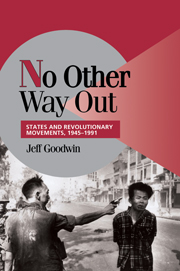Book contents
- Frontmatter
- Contents
- Figures, Tables, and Maps
- Abbreviations and Acronyms
- Preface and Acknowledgments
- Part 1 Introduction
- Part 2 Southeast Asia
- Part 3 Central America
- CHRONOLOGY FOR CENTRAL AMERICA
- 5 THE FORMATION OF REVOLUTIONARY MOVEMENTS IN CENTRAL AMERICA
- 6 NOT-SO-INEVITABLE REVOLUTIONS: THE POLITICAL TRAJECTORY OF REVOLUTIONARY MOVEMENTS IN CENTRAL AMERICA
- Part 4 Further Comparisons and Theoretical Elaborations
- Annotated Bibliography
- Index
- Titles in the series
5 - THE FORMATION OF REVOLUTIONARY MOVEMENTS IN CENTRAL AMERICA
Published online by Cambridge University Press: 05 June 2012
- Frontmatter
- Contents
- Figures, Tables, and Maps
- Abbreviations and Acronyms
- Preface and Acknowledgments
- Part 1 Introduction
- Part 2 Southeast Asia
- Part 3 Central America
- CHRONOLOGY FOR CENTRAL AMERICA
- 5 THE FORMATION OF REVOLUTIONARY MOVEMENTS IN CENTRAL AMERICA
- 6 NOT-SO-INEVITABLE REVOLUTIONS: THE POLITICAL TRAJECTORY OF REVOLUTIONARY MOVEMENTS IN CENTRAL AMERICA
- Part 4 Further Comparisons and Theoretical Elaborations
- Annotated Bibliography
- Index
- Titles in the series
Summary
That revolutionary processes broke out only in some countries, even though economic change was a factor across the region, suggests that the disorders of capitalist modernization are not a sufficient explanation for the emergence of radical political challenges. The political conditions and institutions that framed those structural changes and their negative impacts on particular groups and classes must also be considered.
– Carlos Vilas (1995: 79)I believe that the people have different motivations for fighting than those acquired by a more sophisticated leadership. Politically, people have more rudimentary motivations: often they simply have no choice, like in the case of the peasantry, such an important component of the struggle in El Salvador, which joined the guerrillas because it couldn't be on the other side, because their families were simply murdered. They know since they were born that the Army is evil and that the guerrillas are against the Army. That's about it.
– Salvador Samayoa, Salvador guerrilla leader (quoted in Castañeda 1993: 241–2)In the preceding chapters, I have tried to demonstrate how a state-centered approach illuminates the uneven development of revolutionary movements in postwar Southeast Asia. But perhaps the power of this approach for that region, at that time, has something to do with the fact that these societies were formal colonies ruled by powerful external states that were then suddenly occupied by yet another foreign power, Japan.
- Type
- Chapter
- Information
- No Other Way OutStates and Revolutionary Movements, 1945–1991, pp. 142 - 179Publisher: Cambridge University PressPrint publication year: 2001



